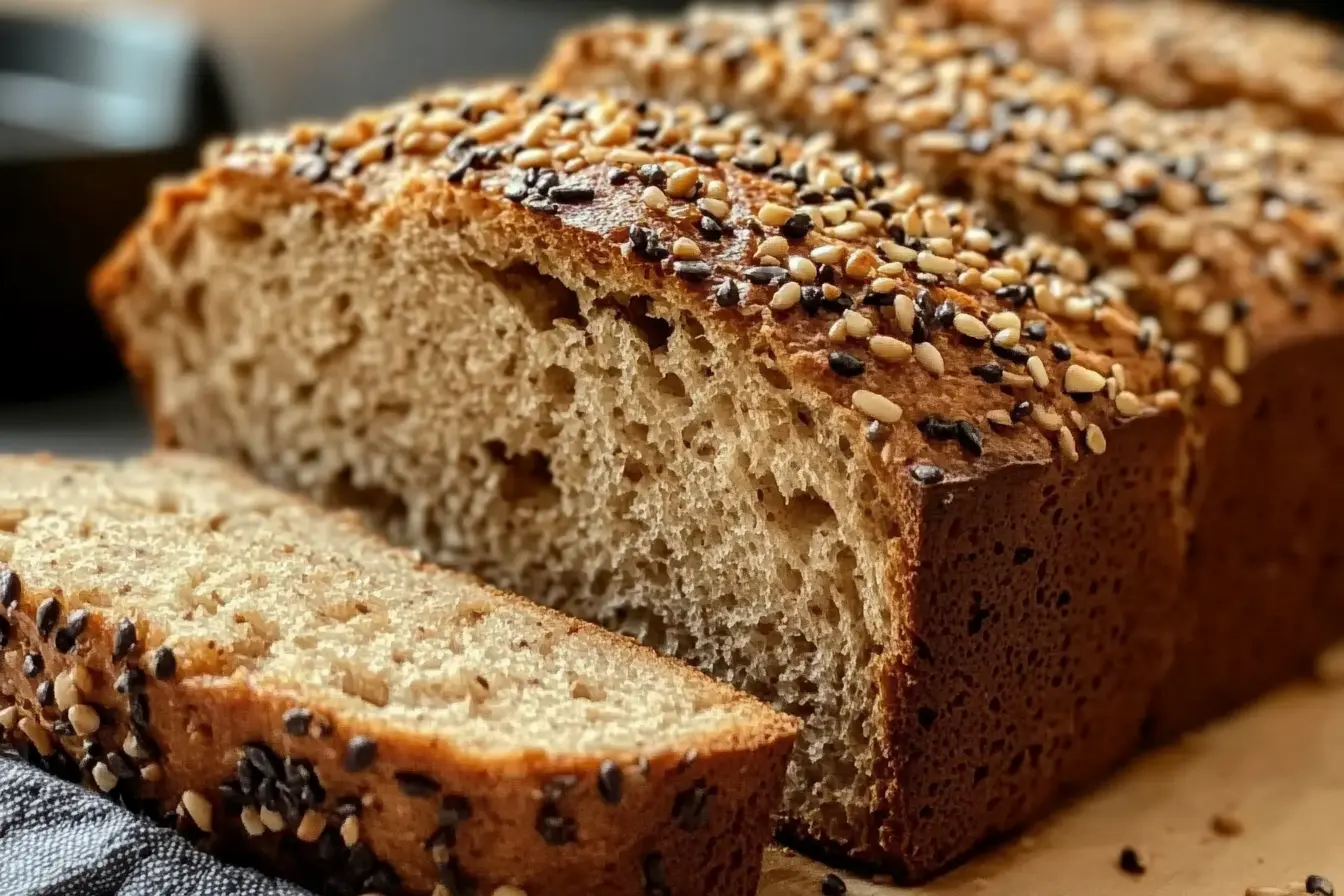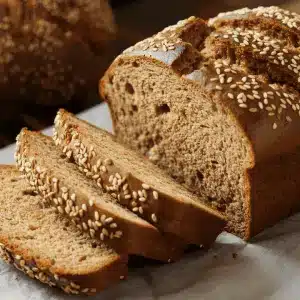Attention all health-conscious bakers and bread lovers! Are you looking for a delicious way to increase your protein intake without compromising on taste? Look no further than this incredible protein bread recipe! Imagine slicing into a warm, golden loaf of bread that not only satisfies your cravings but also packs a powerful protein punch. Desire to make a positive change in your diet? This protein bread recipe is the perfect solution, offering a healthy and tasty alternative to traditional bread. Let’s dive into the ingredients and steps to create this nutritious masterpiece!

Protein bread is a game-changer for those seeking a nutritious and satisfying alternative to regular bread. By incorporating protein-rich ingredients like protein powder, seeds, and nuts, this bread provides a significant boost to your daily protein intake. Protein is essential for building and repairing tissues, maintaining muscle mass, and keeping you feeling full and energized. Whether you’re a fitness enthusiast, a busy professional, or simply looking to make healthier choices, protein bread is an excellent addition to your diet. In this article, we’ll explore the ingredients, preparation steps, variations, and nutritional benefits of this delicious and wholesome bread.
Ingredients and Their Benefits
To make protein bread, you’ll need the following ingredients:
– 2 cups whole wheat flour: Rich in fiber, vitamins, and minerals, whole wheat flour provides a nutritious base for the bread.
– 1 cup protein powder (whey, casein, or plant-based): The star ingredient that boosts the protein content of the bread, helping you meet your daily protein requirements.
– 1/2 cup mixed seeds (e.g., chia, flax, sunflower, pumpkin): Seeds are packed with healthy fats, fiber, and micronutrients, adding texture and nutrition to the bread.
– 1/2 cup chopped nuts (e.g., almonds, walnuts, pecans): Nuts provide healthy fats, protein, and a satisfying crunch to the bread.
– 2 tsp baking powder: Helps the bread rise and achieve a light, fluffy texture.
– 1 tsp salt: Enhances the flavors of the other ingredients.
– 1 1/2 cups water or milk: Binds the ingredients together and provides moisture to the dough.
Optional ingredients and substitutions:
– Honey or maple syrup for a touch of sweetness
– Herbs and spices like rosemary, garlic powder, or cinnamon for added flavor
– Gluten-free flour blend for a gluten-free version
– Plant-based protein powder and non-dairy milk for a vegan version
Protein Bread Recipe Preparation Steps
Making protein bread is a straightforward process that yields delicious results. Follow these step-by-step instructions to create the perfect dough:
– In a large mixing bowl, combine the dry ingredients: whole wheat flour, protein powder, seeds, nuts, baking powder, and salt. Mix well to ensure even distribution.
– In a separate bowl, whisk together the wet ingredients: water or milk, and any optional sweeteners like honey or maple syrup.
– Gradually pour the wet mixture into the dry ingredients, stirring with a wooden spoon or dough whisk until a sticky dough forms. If the dough feels too dry, add a little more water; if it’s too wet, add a bit more flour.
– Once the dough comes together, transfer it to a lightly floured surface and knead it for about 5-7 minutes. Kneading helps develop the gluten in the flour, giving the bread a better structure and texture.
– After kneading, shape the dough into a ball and place it in a greased bowl. Cover the bowl with a damp cloth or plastic wrap and let the dough rest in a warm, draft-free place for about an hour or until it doubles in size.
Tips for ensuring the dough rises properly:
– Make sure the yeast is active and not expired. If using dry yeast, proof it in warm water with a pinch of sugar before adding it to the dough.
– Keep the dough in a warm environment, around 75-80°F (24-27°C). A slightly preheated oven or a warm, sunny spot works well.
– Avoid overworking the dough, as this can cause the gluten to break down and result in a dense, heavy bread.
Protein Bread Recipe Baking Instructions
Once your protein bread dough has risen, it’s time to bake it to perfection. Follow these simple steps:
– Preheat your oven to 375°F (190°C) and lightly grease a 9×5-inch loaf pan.
– Punch down the risen dough to release any air bubbles and transfer it to a lightly floured surface.
– Shape the dough into a loaf by gently pressing it into a rectangle, then rolling it up tightly from one of the shorter ends. Pinch the seam to seal it and tuck the ends underneath.
– Place the shaped loaf into the prepared pan, seam-side down. Cover it with a damp cloth and let it rise again for about 30 minutes or until it’s puffy and nearly doubles in size.
– Bake the bread in the preheated oven for 35-40 minutes. To check for doneness, tap the bottom of the loaf; it should sound hollow. You can also use a thermometer to check the internal temperature, which should reach 190-200°F (88-93°C).
– Remove the bread from the oven and let it cool in the pan for 5 minutes before transferring it to a wire rack to cool completely.
Remember, oven temperatures may vary, so keep an eye on your bread during baking. If the top browns too quickly, cover it with foil to prevent burning. Once cooled, slice and enjoy your delicious, homemade protein bread!
Variations of Protein Bread
One of the wonderful things about this protein bread recipe is its versatility. Here are some tasty variations to try:
– Gluten-free version: Substitute the whole wheat flour with a gluten-free flour blend and add 1 tsp of xanthan gum to help with texture and binding.
– Vegan version: Use plant-based protein powder, such as pea or rice protein, and replace the water or milk with non-dairy alternatives like almond or soy milk.
– Flavored protein bread: Add your favorite herbs, spices, or dried fruits to the dough for a unique twist. Some delicious combinations include:
– Rosemary and garlic for a savory loaf
– Cinnamon and raisins for a sweet and comforting bread
– Sun-dried tomatoes and basil for a Mediterranean-inspired flavor
– Seeded crust: Brush the top of the loaf with an egg wash or water and sprinkle on additional seeds before baking for a crunchy, nutritious crust.
Feel free to experiment with different ingredients and ratios to create a protein bread that suits your taste preferences and dietary needs.
Serving Suggestions
Protein bread is incredibly versatile and can be enjoyed in countless ways. Here are some serving ideas to inspire you:
– Sandwiches: Use protein bread as a base for your favorite sandwich fillings, such as turkey and avocado, hummus and vegetables, or peanut butter and banana.
– Toast toppings: Toast a slice of protein bread and top it with:
– Mashed avocado and a poached egg for a protein-packed breakfast
– Almond butter and sliced strawberries for a sweet and satisfying snack
– Smoked salmon, cream cheese, and capers for a gourmet open-faced sandwich
– Bread bowls: Hollow out a small loaf of protein bread and fill it with hearty soups or chili for a comforting and nutritious meal.
– Breadcrumbs: Pulse stale protein bread in a food processor to create breadcrumbs for coating chicken, fish, or vegetables before baking or frying.
– French toast: Dip slices of protein bread in a mixture of eggs, milk, and cinnamon for a high-protein twist on classic French toast.
Pair your protein bread creations with a side salad or a cup of soup for a complete and satisfying meal.
Storage Tips
To keep your protein bread fresh and delicious, follow these storage tips:
– Room temperature: Store the bread in an airtight container or plastic bag at room temperature for up to 3-4 days.
– Refrigeration: If you want to extend the shelf life of your bread, store it in the refrigerator for up to a week. Keep in mind that refrigeration may cause the bread to dry out slightly.
– Freezing: For longer storage, slice the bread and wrap it tightly in plastic wrap or aluminum foil before placing it in a freezer-safe container. Freeze for up to 2-3 months.
– Thawing and reheating: To thaw frozen bread, remove the desired number of slices and let them come to room temperature. You can also pop them in the toaster or oven to refresh and crisp up the texture.
By storing your protein bread properly, you can enjoy its goodness for days or even weeks to come.
Nutritional Information
One of the main benefits of protein bread is its impressive nutritional profile. A typical slice of protein bread (based on this recipe) contains:
– Calories: 150-200, depending on the specific ingredients used
– Protein: 10-15 grams, providing a significant portion of your daily protein needs
– Carbohydrates: 15-20 grams, mostly from whole grains and seeds
– Fat: 5-7 grams, primarily healthy fats from nuts and seeds
Protein bread is an excellent choice for those following low-carb or high-protein diets, as it offers a balanced macronutrient ratio. The high protein content helps with satiety, muscle building and repair, and weight management. Additionally, the fiber from whole grains and seeds promotes digestive health and helps regulate blood sugar levels.
Keep in mind that nutritional values may vary slightly based on the specific ingredients and quantities used in your protein bread recipe.
Frequently Asked Questions
- Can I use a bread machine to make protein bread?
Yes, you can adapt this recipe for a bread machine. Simply add the ingredients to the machine in the order recommended by the manufacturer, choose the whole wheat or basic bread setting, and let the machine do the work.
- How long does protein bread last?
Homemade protein bread typically lasts 3-4 days at room temperature, up to a week in the refrigerator, or 2-3 months in the freezer when stored properly in an airtight container or plastic bag.
- Can I add sweeteners to the bread?
Yes, you can add a small amount of natural sweeteners like honey, maple syrup, or dates to the dough for a slightly sweeter taste. However, keep in mind that adding too much sweetener may affect the texture and rise of the bread.
- Is protein bread suitable for weight loss?
Protein bread can be a helpful tool for weight loss, as it is more filling and satisfying than traditional bread due to its high protein content. However, it’s essential to consider portion sizes and overall calorie intake for successful weight loss.
- Can I use different types of flour?
While this recipe calls for whole wheat flour, you can experiment with other types of flour, such as spelt, rye, or oat flour. Keep in mind that different flours have varying protein and gluten contents, which may affect the texture and rise of the bread. If using gluten-free flours, add xanthan gum to help with binding and structure.
Conclusion
Protein bread is a game-changer for health-conscious bread lovers. By combining wholesome ingredients like whole wheat flour, protein powder, seeds, and nuts, this recipe creates a delicious and nutritious loaf that packs a powerful protein punch. Not only does protein bread provide essential nutrients for overall health and well-being, but it also offers a satisfying and filling alternative to traditional bread.
Whether you’re a fitness enthusiast, a busy professional, or simply looking to make healthier choices, this protein bread recipe is a must-try. With its easy preparation steps, versatile variations, and convenient storage options, you can enjoy fresh, homemade protein bread whenever the craving strikes.
So, what are you waiting for? Grab your apron, gather your ingredients, and get ready to embark on a delicious and nutritious protein bread adventure! Don’t forget to share your creations and favorite variations with friends and family – they’ll thank you for introducing them to this incredible, protein-packed delight.

